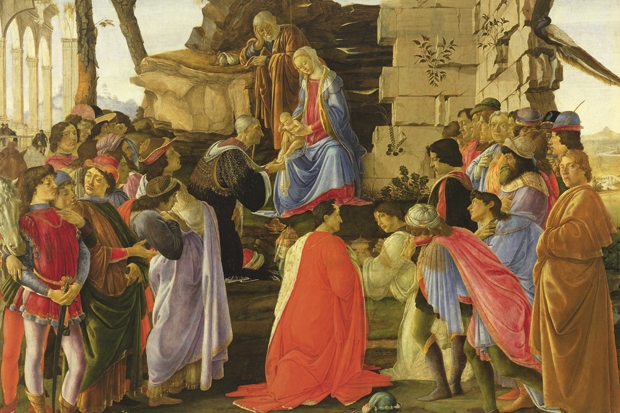In the vast Benedictine monastery of Monte Oliveto Maggiore between Siena and Rome, the cycle of frescoes depicting the life of St Benedict by Giovanni Anionio Bazzi includes a charming self-portrait of the artist standing with a couple of pets at his feet, for all the world a 16th-century Italian Dorothy with a brace of Totos. (A detail of the painting is reproduced overleaf.)
Bazzi did not earn his popular soubriquet of ‘Sodoma’ for nothing — though Vasari is not always reliable — but if his life was the scandalously licentious and dishonourable thing that Vasari would have us believe, then this only places him in the mainstream of the world described in Alexander Lee’s fascinating new book. ‘It was a period of sex, scandal and suffering,’ Lee writes. ‘Its cities were filled with depravity and inequality, its streets thronged with prostitutes and perverted priests, and its houses played home to seduction, sickness, shady backroom deals and conspiracies of every variety.’
If there is a problem with The Ugly Renaissance, a book full of detail and close readings of some of the greatest paintings of the period, it is that Lee asks us to be surprised by something that is unlikely to surprise many of his readers. He is right, of course, when he says that the traditional picture of Renaissance Italy is one of light and beauty, but from Elizabethan anti-Catholic propaganda and 16th-century satirical protestant woodcuts down to Derek Jarman’s Caravaggio and Jeremy Irons in The Borgias, there has always been a popular view of papal Rome or Medici Florence as a world of violence, corruption and every conceivable — and inconceivable — filth.
Does anyone really look at the Raphael portrait of Leo X and not see a study in ruthless dynastic ambition? Is it possible to view the great Uccello funerary monument to Sir John Hawkwood in Florence’s Duomo and not recall the violence and brutality of early Renaissance Italy? It is hard to believe that anyone since E.M. Forster’s Lucy Honeychurch has imagined the Renaissance with the kind of naïve wonder that Lee imputes to us; but if his arguments seem more of a convenience than a fact of historiography, it still frees him to explore the dualities of creative brilliance and human baseness with a mastery of sources and a popular touch that vividly brings the whole period to life.
The first section is an exercise in ‘historical imagination’ — a fictive journey of the artist, Michelangelo, across a Florence which needs and gets its Savonarola. But it is with his second section, on the Renaissance patron, that this book really hits its stride. Taking Benozzo Gozzoli’s ‘Journey of the Magi’, commissioned by Cosimo de’ Medici for the Palazzo Medici Riccardi, as his starting point, Lee examines how businessmen, bankers, mercenary generals and the Church all used their patronage of art and artists to further their own ends in this world and in the next.
It would probably have come as little surprise to contemporaries familiar with his methods to find a soberly suited Cosimo — the de facto ruler of Florence, puppet-master to the Signoria — taking such an apparently minor role in Gozzoli’s dazzling pageant, but they would have recognised his modesty for the artifice it was. Lee shows how the whole composition was from the start manipulated by Cosimo for complicated diplomatic and family purposes, and family and ambition were again at the heart of the business when, ten years after Cosimo’s death, Gaspare di Zanobi del Lama commissioned Botticelli’s ‘Adoration of the Magi’ for his family’s chapel in S. Maria Novella.
It was a piece of blatant social climbing by association. Lama, a dubious minor banker with aspirations above his station, instructed Botticelli to people the ‘Adoration’ with the Florentine banking aristocracy. Foremost among them, a king kneeling in adoration of the Christ-child, is Cosimo. On either side, the scene is stacked with Medici sons, grandsons and associates, as well as the oily Lama himself. And if it’s a bit of a shock to think of Florence’s answer to the boardroom of the RBS featuring so prominently in Bethlehem, it is as nothing compared to the appearance of the appalling condottiero Sigismondo Pandolfo Malatesta in a painting by Piero della Francesca. No pious image could be more blasphemous than this luminously beautiful painting of the kneeling Sigismondo — psychotic torturer, murderer, serial rapist — with his serenely elegant hounds, praying to the patron saint of soldiers, another Sigismond, who, true to style, had his own son strangled.
An ugly thought, but Alexander Lee more than makes good the title of his book. The Age of Discovery was, in Italy, as he shows in the final section, no dawn of expanding sympathies., but rather,
An age in which other peoples and cultures were mercilessly raped, while anti-Semitism and Islamophobia reached fever-pitch, and ever more insidious forms of bigotry and prejudice were developed to accommodate the discovery of new lands.
I’m going to choose my Christmas cards rather more carefully this year.






Comments